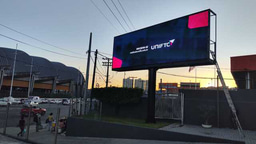Transparent LED Technologies: Innovation That Lets You See Through

In our LANG Insights Newsletter at LinkedIn, we have already looked at transparent products from the established and reliable GhosT to newer concepts like Muxwave and LUCY: Transparency in LED and display technology is still one of the most exciting topics in the current ProAV industry. It’s not just the creative and versatile applications that fascinate but also the cutting-edge technology behind it, which continues to push boundaries and deliver groundbreaking innovations.
The Technology Behind Transparency
Modern transparent LED products are built using a grid of pixels and gaps, allowing both light and images to pass through. Advanced active matrix technologies ensure that technical components like support structures or driver chips remain hidden. This results in great physical transparency rates, while maintaining high performance and delivering exceptional visual quality.
By comparison, transparent OLED displays are a bit more limited in their possibilities. Their transparency reaches up to 40 % with screen sizes of up to 55 inches – as seen with GhosT, for example. Transparent LED panels, like Muxwave, are more scalable in comparison and can be applied to a wide range of use cases.
One of the most promising advancements in this field is the use of Micro-LEDs—tiny diodes with dimensions of less than 100 micrometers. These allow for ultra-high resolutions in extremely compact designs. Prototypes like the AUO display, featuring a pixel pitch of just 0.3 millimeters, illustrate what’s possible. As mass production of such fine, transparent displays becomes more feasible, the potential for even greater transparency, efficiency, and everyday usability comes closer to reality.
Diverse Applications
Transparent LED technology is already making waves in a variety of fields. Take, for example, the entrance to the exhibition halls at ISE 2024: the entire glass facade was fitted out with Muxwave panels. From the outside, it delivered stunning visual content, while from the inside, it maintained its incredible transparency.
This high-quality, transparent technology creates powerful effects across a range of applications. In architecture and digital signage, advertising and entertainment, and even in mixed and augmented reality, transparency introduces depth and layers to AV installations that no other medium can achieve.
A New Realm of Creative Freedom
What sets transparent LED technologies apart is the creative freedom they unlock. Surfaces that were once static and purely functional can now be transformed into dynamic, interactive displays. These panels enable breathtaking 3D effects, seamless blending of digital content with real-world environments, and innovative spatial solutions like LUCY—a transparent partition wall used at trade shows as an interactive design element.
With transparent LED walls and displays, designers and architects can create installations that feel naturally integrated into their surroundings while still delivering visually striking digital content. They open up new possibilities for immersive experiences in architecture, advertising, and entertainment, making it easier than ever to blend technology and creativity.
The Future – and Presence – is See-Through
Transparent LED technologies combine outstanding visual quality with the ability to seamlessly blend into their environment. They have the potential to redefine the way we think about displays by creating immersive, multidimensional experiences that transform spaces in entirely new ways.
The future of LEDs and displays is set to become increasingly transparent in some ways—and with it, we’re poised to explore fascinating new perspectives that will inspire and captivate audiences for years to come.






Please sign in or register for FREE
If you are a registered user on AVIXA Xchange, please sign in
Transparent LED technologies are truly inspiring! Your article highlights their creative potential and practical applications, from architecture to entertainment. I especially appreciated the emphasis on how these displays seamlessly blend with environments while delivering stunning visuals. Great insights into an evolving technology!